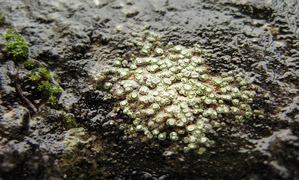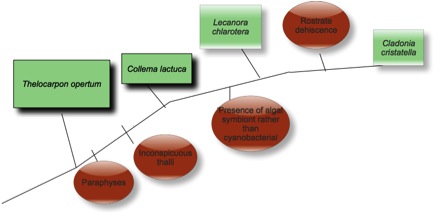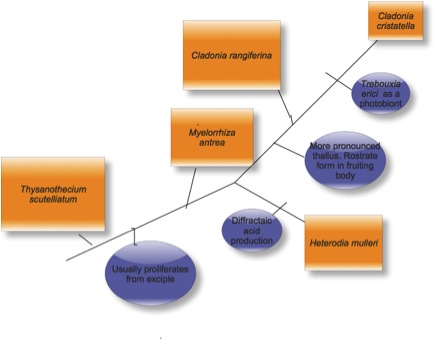Phylogenetics
From an evolutionary standpoint, it's interesting to know where things originate from. Though no common ancestor to the lichens has yet been identified, it is still possible to classify these organisms based on their similarities and differences.
Out of the approximately 25,000 known species of lichen, only 20 named species fall out of the phylum ascomycetes. Most lichens, along with Cladonia cristatella, fall in the lecanormycetes class.
The most common way people have classified lichens is by their appearance. Though this can be useful when other methods are unavailable, strictly looking at morphology will not tell you much about the organism. In fact, many lichens, even of the same species, may be pleiomorphic. This means that one lichen species may take different shapes or colors. The best analogy is to compare a lichen to a dog. Every domestic dog that we keep as pets (for the most part) is called Canis lupus. Just because a dog has this genus and species tag attached to it does not mean that it follows a strict morphology. When looking at a poodle and a yellow lab, the differences are very striking, yet they are the same species. In some ways, lichens are very similar.
Crustose: Crustose lichens resemble crust, hence the name. An example of a crustose lichen is Caloplaca sp.
Fruticose: These lichens produce structures that resemble fruits. 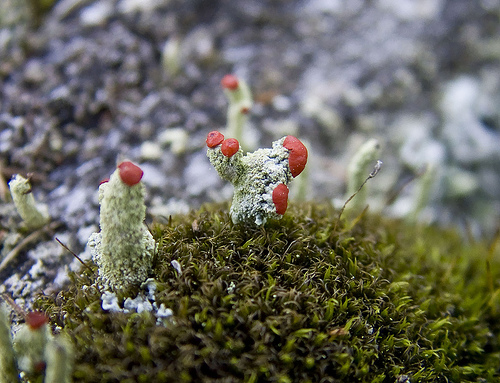 Our lichen of interest, Cladonia cristatella falls under this morphological category. The organism shown here is a relative of Cladonia cristatella named Cladonia transcendens.
Our lichen of interest, Cladonia cristatella falls under this morphological category. The organism shown here is a relative of Cladonia cristatella named Cladonia transcendens.
Squamulose: The species pictured here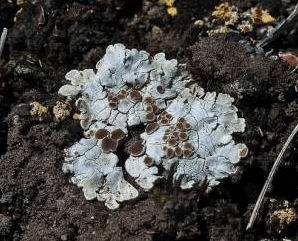 's called Squamarina lentigera, also known as the white rim lichen. The term squamulose is coined because it has a scaly structure of the lichen.
's called Squamarina lentigera, also known as the white rim lichen. The term squamulose is coined because it has a scaly structure of the lichen.
![]()
Foliose: The final common classification of lichens used.
This name originated since this group resembles leaves, hence the name foliose.
This can be seen with Xanthoria parietina.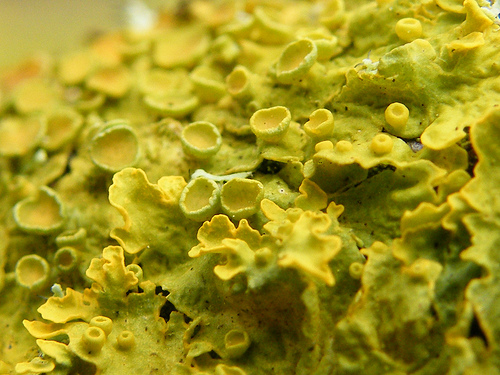 .
.
Common Relatives
As said earlier, the common ancestor is not known C. cristatella, or any species of lichen. The development of molecular techniques have made it easier to classify these organisms. Even today, these organisms are being taxinomically redefined, so what holds true today may not be true in a few years.
The image above is a short representation of a phylogenetic tree for Cladonia cristatella. Since not much is known about this species, it's somewhat difficult to classify it in relation to other organisms. Certain characteristics do stand out however when observing lichens. The first differentiating characteristic, paraphyses, refers to a spore bearing layer. This means that the organism before this marking, Thelocarpon opertum, does not contain this structure. Next, the incospicuous thalli refers to the main part of the lichen. Many lichens have thalli present, including Cladonia. The long green portion of the organism that resembles a stem is called a thallus. The next step in this tree is the presence of an algal fungal symbiont versus a cyanobacterial photosymbiont. The final differentiating factor mentioned is rostrate dehiscenence. This basically means a more complex fruiting body. Rostrate is Latin for beak and dehiscenence is Latin for spontaneous opening. It's basically referring to the fruiting body at the top of the lichen. In our species, it's the red portion at the top.
This tree focuses more on the family cladoniaceae. The exciple is the outer covering of the apothecium of the lichen Organisms to the right of this proliferate from here. Heterodia mulleri is noted for its acid production. Rostrate fruiting bodies classify the lichens that are more closely related to C. cristatella. The most significant indicator of a close relation is the presence of Trebouxia erici. This crucial photobiont allows us to have an idea of where this organism resides phylogenetically. Unfortunately, research is still ongoing while further work needs to be completed in order to discover the common ancestors.
Though there are no other lichens or algal species listed on www.multipleorganisms.net, there are a few fungal species that are worth taking a look at.
The cyanobacteria link is interesting to observe because in about 20% of lichens, this is the photobiont present.

